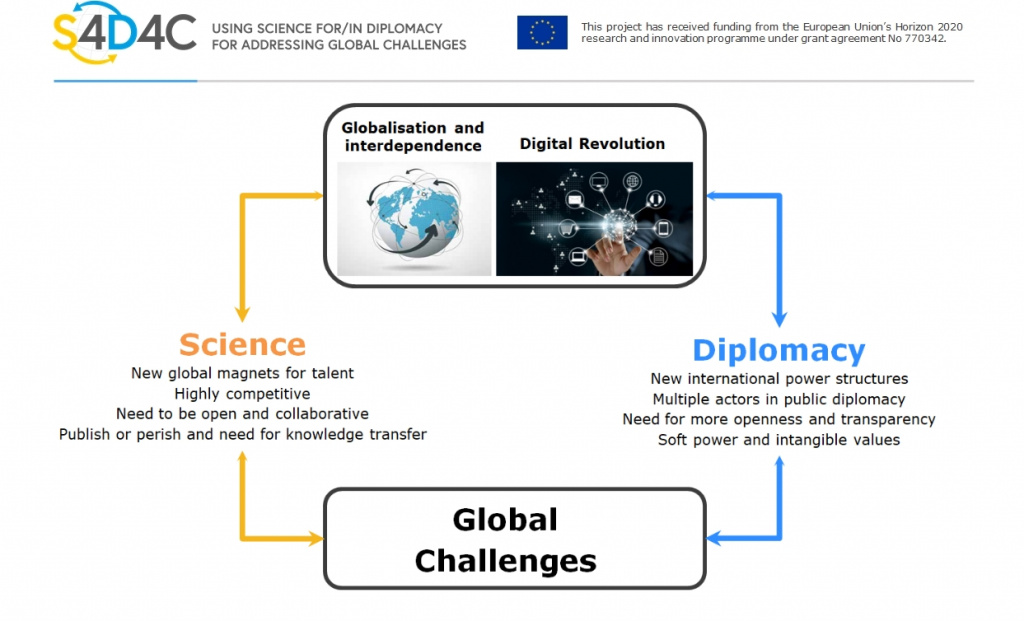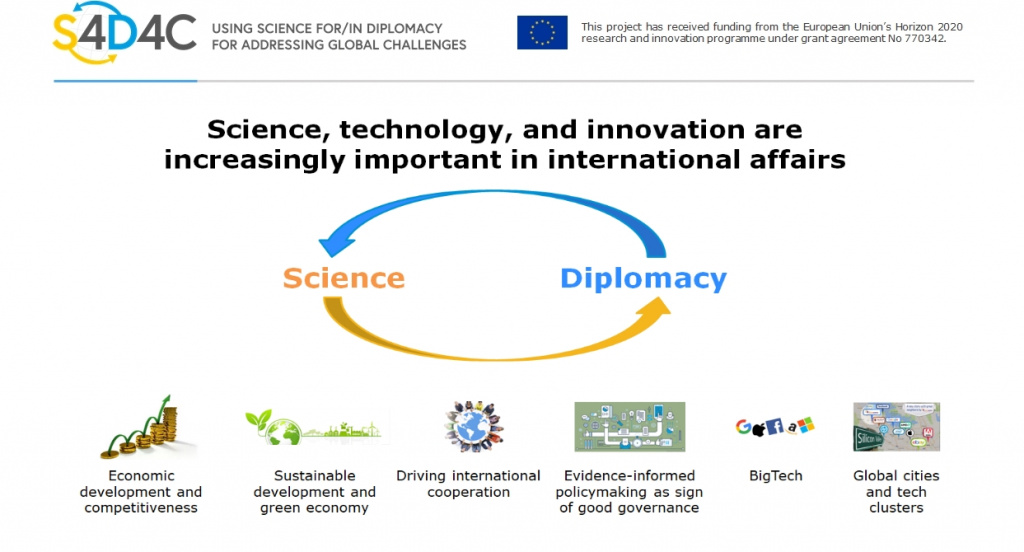2.3 Science Diplomacy in the World Today
After these brief introductions, we will focus now on the current state of matters for both worlds. Globalisation and the growth of interdependence, as well as digitalisation, have affected both the system of science and that of diplomacy. This brief explanation will set the scene to then explain the interactive space that science diplomacy actually represents.
Let’s get started!
Science, Technology and Innovation
Science, technology and innovation, have been a global enterprise or joint endeavour throughout history and many different civilisations. The history of each scientific discipline is unique and so is that of how countries established their own research and innovation national systems mainly during the 20th Century. The leading efforts of the United Nations and especially the Organisation for Economic Co-operation and Development (OECD) helped national governments to establish their research and development systems, and have a common language about science and technology policy as well as economic development policy, involving forms of research, research areas, division of professional sectors, research and innovation indicators, types of scientists, etc. (see The OECD Frascati Manual).
As a consequence, the international science system comprises a rich constellation of stakeholders: international scientific organisations, national governments and research councils involved in funding research and innovation, academic institutions such as universities, research centres and public foundations, international and national academies and learned societies, large research infrastructures, large companies and SMEs, NGOs, private foundations and charities involved in funding and many different stakeholders interacting at all levels of governance.
The increasing globalisation has also had an impact on science, technology and innovation, as it has improved the exchange of knowledge, resources and talent worldwide, but certain challenges remain (Royal Society, 2011). Similar to what occurs in the diplomatic perspective, the rise of new scientific powers (China, India, Brazil, etc.) and the emergence of scientific nations in the Middle East, South-East Asia and North Africa both help explain the shift to an increasingly multipolar scientific world, where Western nations no longer retain control or are leaders in the field.
International scientific collaborations are increasing at an exponential pace, academic papers resulting from international collaborations are demonstrated to have a bigger impact than those resulting from national collaborations.
Individual scientists move easily between national borders seeking to work with the best of their peers and to gain access to complementary resources, equipment and knowledge. This talent circulation needs careful consideration from nations as they may face challenging scenarios (brain drain). New creative approaches need to be implemented to keep scientists abroad engaged with their national systems for both knowledge exchange and new international mobility opportunities.
Lastly, science and technology will produce solutions to global challenges such as climate change, energy sustainability, infectious disease, food security, etc. These challenges will not only require international scientific collaboration, global policy implementation will also be mandatory if they are to be tackled and solved.
Diplomacy
Traditional diplomacy has dominated international relations for nearly five centuries and is very different from today’s diplomacy. Adding to the traditional bilateral diplomacy, states are today involved in issues that affect several countries at once, the community of nations as a whole. In addition to their traditional framework of embassies, states also have permanent missions to international organisations in New York, Geneva, Rome, Vienna or Paris.
The community of nations underwent profound transformations with the dissolution of the Soviet Union and the rise of new powerful nation states such as China, India, Brazil and the Asian Tigers.
With a new balance of power, the world has also witnessed a growth of networks of interdependence that transcend national and regional boundaries. The world today is more complex, interdependent and interconnected than ever before (Kehoane and Nye, 2000). Both globalisation and digitalisation are transforming our societies to a large extent: trade, financial markets, international relationships, knowledge and cultural exchanges, communications and transportations.
The complexity and interdependence of the world today makes any big or small alteration in any network point be felt immediately on the other side of the network. From economic crashes to exchange of information (or misinformation), the effects register almost instantly.
The international landscape has also witnessed the increasing relevance of additional stakeholders in public diplomacy such as Small and Medium Enterprises (SMEs), universities, Regional Organisations, Non-Governmental Organisations (NGOs) and civil society movements. These new players take advantage of international conferences to express themselves, lobby and influence the international legal framework.
Public opinion and global branding have become key factors in the international image of a country. Harnessing a country’s “soft-power” tools or intangible assets such as culture, tourism, cuisine, cinema, or science, technology and innovation (Copeland, 2009) is a new way to act or be perceived as a decision maker in contrast to the use of coercive means, such as military power or payments, traditional “hard power” tools. Therefore countries combine strategically hard- and soft-power tools in what can be framed as “smart power” (Nye, 2004).

The interactive space of science and diplomacy
Under this global and complex scenario, there is a need to build a common ground of mutual trust and understanding between the scientific and diplomatic communities. Science and technology are becoming increasingly more important in international relationships. As Daryl Copeland (2015) explains, this is because science, technology and innovation are drivers of:
- economic progress;
- equitable, humanitarian and sustainable development; and
- evidence-based decision making and public policy development, which are hallmarks of good governance and responsible public administration, so foreign policy must also check upon scientific evidence
As Grimes & Hennessey (2015) also point out science is a driver for international cooperation to reach common goals and it can be included within a nation’s soft-power toolkit.
As scientists and diplomats rarely interact with each other on a day-to-day basis, the need for a transboundary field such as science diplomacy that will foster more networking, trust and mutual understanding among these is more important than ever.
Science diplomacy is relevant, effective, and potentially transformative. It can play a key role in responding to some of the most elemental challenges facing the international community (Copeland, 2015). In the following topics, you will learn different definitions and theoretical approaches to increase your understanding of this complex and multidimensional concept.

| Read more about the current world scenario using the references below: – Copeland, Daryl (2009): Guerrilla Diplomacy: Rethinking International Relations. Boulder: Lynne Rienner Publisher. – Copeland, Daryl (2015): “Bridging the Chasm: Why Science and Technology Must Become Priorities for Diplomacy and International Policy.” Science & Diplomacy, Vol. 4, No. 3 (September 2015) (Link). – Grimes, Robin, Emma Hennessey (2015): “Why Science Is in the Diplomatic Toolkit.” Science in Parliament Vol 72, No 2, May/June (Link). – Kehoane, Robert O., and Joseph S. Nye (2000): “Globalization: What’s New? What’s Not? (And So What?)”. Foreign Policy, Spring, pp. 104-119. – Nye, Joseph S. (2004): Soft Power: The Means to Success in World Politics. Public Affairs: New York. – Royal Society, The (2011): Knowledge, Networks and Nations: Global scientific collaboration in the 21st century. Royal Society Policy Document 03/11. London: The Royal Society. March (Link). – Ruffini, P-B. (2017): What is Science Diplomacy?, In: Ruffini, P-B., Science and Diplomacy: A New Dimension of International Relations, Cham: Springer International Publishing, pp. 11-25. |

The material provided under this course is licensed under a Creative Commons Attribution 4.0 International License.